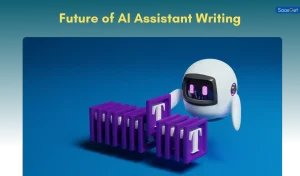In today’s fast-paced digital world, content creation has become essential. However, creating content manually can be time-consuming and challenging. Here comes the solution: AI assistant writing. With advancements in artificial intelligence (AI), writing assistants have become a powerful tool for individuals and businesses alike. This article will explore the basics of AI assistant writing, its benefits, how it works, and why it can be a game-changer for content creators of all kinds.
What is AI Assistant Writing?
AI assistant writing refers to the process of using artificial intelligence tools to help with writing tasks. These tasks can range from generating full articles, crafting social media posts, summarizing information, and even editing and proofreading. An AI-powered writing assistant uses sophisticated algorithms and large datasets to understand language patterns, allowing it to produce coherent and relevant content.
Whether you’re a student, professional writer, marketer, or business owner, an AI writing assistant can support your writing needs, saving time and improving productivity.
How Does AI Assistant Writing Work?
AI assistant writing uses machine learning, natural language processing (NLP), and deep learning to generate human-like text. Here’s a breakdown of how it works:
- Onvocado Lifetime Deal Review: Is It Worth Your Investment?
- CX Genie Lifetime Deal Review: Is It Worth Your Investment?
- SalesNexus Lifetime Deal Review: Pros, Cons, and What You Need to Know
- Gato GraphQL Lifetime Deal Review: Is It Worth Your Investment?
- Abun Lifetime Deal Review: Discover Features, Pricing, and Benefits
- Data Collection and Training: AI assistants are trained on vast amounts of text data. They “learn” language patterns, sentence structures, and vocabulary from this data.
- Understanding Context and Intent: Through NLP, an AI assistant understands the context of what’s being asked. For example, if you need a blog post on “healthy eating,” the AI will recognize relevant topics and produce content around that theme.
- Generating Content: Once the AI understands the task, it starts generating content. AI assistant writing tools can produce paragraphs, suggest edits, or even rewrite sentences for clarity.
- Editing and Refining: Some AI assistants allow users to refine content by providing suggestions for improving tone, grammar, and structure.
Benefits of AI Assistant Writing
Using AI assistant writing has numerous benefits, especially for those who need to create content regularly. Here are some key advantages:
Time Efficiency: Writing content manually can take hours or even days. AI writing assistants can draft content in minutes, helping you focus on other important tasks.
Cost-Effective: Hiring professional writers can be costly. An AI assistant provides a more affordable option, especially for small businesses or individuals on a budget.
Consistency: AI assistant writing ensures that your content remains consistent in tone, style, and structure. This is especially helpful for businesses that want to maintain a specific brand voice.
Increased Productivity: With an AI writing assistant, you can handle multiple writing tasks more quickly. This increased productivity is beneficial for both personal projects and professional settings.
Improved Grammar and Style: Most AI assistants come with built-in grammar and style checks. This feature helps you create polished and error-free content.
Common Uses of AI Assistant Writing

AI assistant writing is versatile and can be applied in many areas:
Blogging: AI assistants can help generate blog post ideas, outlines, and complete articles. Many bloggers use AI to overcome writer’s block or speed up their content creation process.
Social Media Content: Social media posts require engaging, concise language. AI writing assistants can generate posts tailored for platforms like Facebook, Twitter, and Instagram.
Email Writing: AI can assist in drafting emails for different purposes, whether it’s a professional email or a marketing message.
Academic Writing: While not a substitute for research, AI assistants can help students structure essays, draft summaries, and proofread papers.
Business Reports: Business professionals use AI assistant writing tools to draft reports, proposals, and presentations.
Limitations of AI Assistant Writing: While AI assistant writing offers many advantages, it’s essential to understand its limitations:
Lack of Creativity: AI-generated content may lack the unique creative touch that a human writer can provide. AI assistants rely on data, so their responses may sometimes feel generic.
Context Understanding: AI assistants might struggle with understanding nuanced topics or complex emotions, which can lead to content that misses the intended message.
Ethical Considerations: Relying solely on AI for content generation raises ethical questions about originality and creativity. It’s essential to use AI as a support tool rather than a replacement for human creativity.
Potential for Errors: While AI tools are advanced, they are not perfect. Occasionally, they may produce factual inaccuracies or awkward phrasing.
Choosing the Right AI Assistant Writing Tool
Not all AI writing assistants are the same. Here are a few tips for choosing the best one:
- Evaluate Features: Different tools offer varying features. Some are good at grammar checks, while others excel at content generation. Choose a tool that meets your specific needs.
- User-Friendliness: Look for a tool that is easy to use. A complex interface can be frustrating and time-consuming.
- Customization Options: Some AI writing assistants allow you to customize the tone, style, and format of the content. This feature is helpful for maintaining a consistent brand voice.
- Cost: Many AI writing tools offer free versions with limited features. Consider your budget and choose a tool that offers the best value for money.
- Support and Updates: AI technology is constantly evolving. Choose a tool that offers regular updates and reliable customer support.
How to Get the Most Out of AI Assistant Writing
Here are some tips to maximize the effectiveness of AI assistant writing:
- Define Your Goals: Before using an AI assistant, be clear about what you want. Whether it’s a blog post, email, or social media caption, having a goal helps the AI deliver relevant content.
- Use as a Support Tool: While AI can generate text, it’s best to view it as a support tool. Edit the output, add personal insights, and make sure the content aligns with your message.
- Experiment with Prompts: Many AI assistants rely on prompts to generate content. Experiment with different prompts to get varied results.
- Edit and Proofread: AI-generated content is not always perfect. Review and edit the text to ensure accuracy and relevance.
Future of AI Assistant Writing

The future of AI assistant writing looks promising. As technology advances, AI assistants are expected to become even more sophisticated. In the future, AI could potentially create hyper-personalized content, understand complex human emotions, and generate creative ideas that align closely with human needs. However, human oversight will remain crucial to ensure quality and maintain a unique, authentic voice in content creation.
Frequently Asked Questions (FAQs)
Q: What is AI assistant writing?
AI assistant writing is the use of artificial intelligence to help with various writing tasks, such as generating articles, emails, social media posts, and reports.
Q: Can AI writing assistants replace human writers?
While AI writing assistants are highly efficient, they are not a replacement for human creativity and originality. They serve as helpful tools to support human writers.
Q: Are AI assistant writing tools free?
Some AI writing tools offer free versions with limited features, but many advanced tools require a subscription or one-time payment.
Q: How accurate is AI assistant writing?
AI assistant writing is generally accurate, but it may still produce errors or lack context in complex topics. Always review and edit AI-generated content for best results.
Q: What are the limitations of AI assistant writing?
AI assistants may lack creativity, struggle with nuanced context, and sometimes produce errors. It’s essential to use AI as a support tool rather than a complete replacement for human writing.


